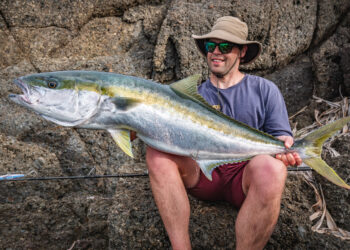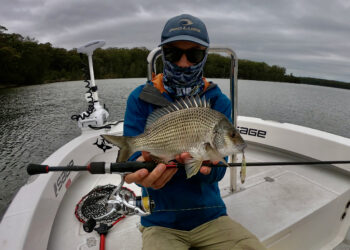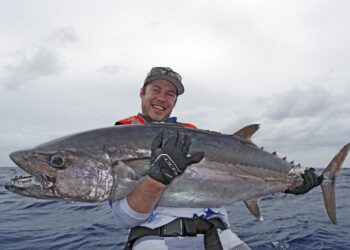WHO wants to catch a big bream? And I’m not talking about any ordinary “big” bream. I’m referring to a bream that’s big enough to make any tournament angler squirm with jealousy. A fish that’s been alive longer than many of you reading this. I’m talking about a monster bream!
I don’t know any fisho who would say no to such a proposition. Catching big bream can be one of the most exciting things an angler can experience – and probably one the toughest. When it all comes together and a genuine 2kg bruiser hits the net, it’s euphoria.
I know a few Top End anglers reading this right now are shaking their heads disapprovingly. Up north bream are used as bait. I don’t expect you northerners to understand it, just like you don’t expect us southerners to understand your overwhelming obsession with barramundi. To many southern fishermen, breaming is something intrinsic, born from our earliest memories of fishing and extending right through to current fishing trends and fads.
Bream fishing is now at an all-time peak in popularity and the once humble bream, known colloquially as a bread & butter species, now generates more revenue in tackle sales than just about any other southern species. If you work in the tackle industry, don’t hold me to that assertion. I was merely generating the emotion necessary to put you in the right mindset. I’m sure you get it, though. Catching bream is now big business and those who can master it are household names with big sponsorships.
It might be a good time to highlight I am NOT one of those anglers. I am simply a weekend hack who loves to catch big bream. I’ve been fortunate to have cut my teeth on one of Australia’s premier bream waterways, the Hawkesbury River. So for this reason, I’ve managed to have good success over the years on bait and, in more recent times, lures.
In this piece, I will go through all I’ve learnt when it comes to targeting big bream with both lure and bait. Regardless the presentation, consistent patterns have always emerged, especially in my home patch. However, I’m certain that the secrets we have unlocked will pay dividends for you, too. Now the last thing we need to highlight is we are talking about real bream. Not thirty-somethings, but forty-plus fish from 1kg and beyond. You will probably hear old stories of 4kg bream being caught. While I don’t deny they could exist, I’ve never seen one. Empirical evidence suggests if you get one over 2kgs these days you’re doing very well.
Soft Plastics
While the majority of my experience with big bream lies in bait, more recently my success has come from using artificials. I now use lures almost exclusively and, to be honest, I find it more challenging and active. I predominantly use two types of lures to catch big bream: soft plastics and blades. If some of you are asking why I haven’t included hard-bodies, in my opinion they lack the consistency on the real big specimens. Catching bream in shin-deep water on small hard-bods might be the technique of choice in Tasmania but here in Sydney, you’re wasting your time.
Now read the next line very carefully. If you want to catch kilo-plus bream on a consistent basis you have to fish “ultra deep”. I’m talking water well in excess of 30 feet. However, the most consistent depth range has been between 50 and 70 feet deep. It is for this reason alone I say hard-bodies are not suitable for the task at hand. You will struggle to find one that will get down 10m plus and put you in the strike zone. The notion that bream forage in shallow water is a correct one, and uneducated bream feeding on the flats get caught regularly. But a wily bream which has been avoiding hooks for over 25 years won’t be as easily fooled. Therefore deep water will give these big, old fish a sense of security and gives you a decent shot of hooking them on a consistent basis. It needs to be noted here, however, that fishing deep is not without its difficulties and challenges.
The first difficulty when fishing ultra deep water is selecting an appropriate sized head to get you in the zone but light enough to still offer a finesse presentation. I use jigheads in the 6g to 9g range to fish these depths. These heavy heads may sound counter-intuitive, especially in light of the current trends to go ultra light with 1/50th sized heads. These may be good on the flats but deep water usually represents the presence of current. Light presentations will be swept well away from where the fish will be holding.
The other factor of fishing deep water is to mate these moderately weighted heads to a plastic that creates movement with minimal rod work. That is why my killer presentation for the big boys is the 65mm and 70mm Squidgy Pro Fish in assorted colours. Squidgey Pros are a supple plastic that swim with negligible force. Even under the steam of current alone, the tail will swim enticingly. Many big bream have picked up the plastic with the rod in the holder, which indicates the lure is enticing the fish “dead sticked” off the bottom. This is usually a good indication that the lure has subtle, life-like movement and also that the fish are ravenous. The 65mm and 70mm presentations are on the large side of the spectrum when you consider some of the lures being used to catch bream. However, the use of 9g jigheads necessitates the use of a slightly larger plastic to balance out the presentation. A 50mm plastic on the same jighead will look unnatural. I guess therein lies the secret. To catch the big suckers you need to entice them with a large meal. It’s effort versus reward. Big fish need big meals to sustain them, so don’t get fooled into the notion they will only chase small prey. I have caught many bream on 5” plastics meant for jewies.
The most successful Squidgy Pro colours have been the Grasshopper and Flash Prawn but on clear bright days Cool Mint has also been a good producer.
Like most other scenarios for bream I tend to use a very subtle retrieve with minimal movements of the rod. It doesn’t take much to scare a paranoid fish sussing out your lure. Due to my single-minded focus of using only fish-profile lures, I will usually employ one soft lift of the lure rather than multiple twitches. The key is to lift the lure off the bottom and swim it back down very naturally, unlike the unpredictable movements of a stickbait. I am trying to mimic a healthy baitfish casually going about its business.
The last advice I can give is use S-Factor. I might sound like a broken record as I always recommend it, but to be honest I wouldn’t go fishing with plastics without it. It was specifically designed to work on bream so you can guarantee this stuff works. Take it from me, my catch rates on bream and mulloway have doubled since I started using it. Apparently it’s like chilli to humans, so only use enough to flavour the plastic. Use too much and a fish’s mouth will burn.
Blades
If the bream are being shy on the moderate sized jigheads, I usually pull out the blades. The good thing about these lures is that they sink like a house brick so for a small profile so you get the best of both worlds: a lure that can be fished ultra deep whilst keeping a good degree of finesse. Like plastics, I tend to work the lure with small hops off the bottom. In fact, my retrieve is almost identical employing only one upstroke of the rod rather than a double twitch and pause.
If bream are on the job the metal varieties work a treat. The metal blades have an intense vibration that calls in bream from long distances. One key benefit of metal blades is that they take very little movement to get the lure pulsating and used in ultra deep water can be “tea-bagged” underneath the boat without scaring the fish. This is done most effectively using the rear tow hole on the blade. Most blades come with snap swivels to make quick changes of the tow points in the field. My favourites to try are Evergreens, TTs and Ecogears.
If the bream are refusing soft plastics and metal blades they are usually in a foul mood. That’s not to say they cannot be caught. It just means you have to go stealth. This is when I pull out the polycarbonate blades. There are plenty to choose from now and in the hands of a novice, it’d be easy to assume they don’t work. Unlike metal blades where you can feel the vibration, poly blades are far more subtle. It’s almost like a leap of faith. You have to assume they are working and have confidence. Look for Squidgy Devilfish, TT’s Ghost Blades and Koolabung X-Ray Blades.
Due to the bony structure of a bream’s mouth I always recommend retro-fitting blades with Owner trebles. Most top line lures these days will usually have Owner as standard.
Bait
While I used to be qualified to commentate on bait fishing for bream, a lot of what I will say here is based on old techniques. While it may be a little outdated, it has been passed down for generations so it may stand the test of time.
The notion of fishing deep for bream on lures was actually devised by my experience with bait. This is what I meant when I said earlier that certain patterns have emerged; I just needed to tweak the lure process to acquire success.
The critical factor for success with bait is not only fishing in quite deep water, but targeting known fish highways. In any river system, fish will travel down preferred routes while migrating. With some crafty investigation it’s easy to spot these channels and begin to piece it all together. One signpost is floating debris. Tides usually filter the debris along main channels which indicates the confluence of merging currents. It’s these currents that usually carry food along with them and fish will generally travel along these lines. If you look closely at the direction of the debris you will see how current bounces from point to point, deviating the flow of water. Once you understand where these highways are in your local waterway, anchoring up in them and introducing berley will put you in the game. My favourite berley for bream is wheat.
The other factor is hard bottom. If you can find a deep rock bar along these current lines you’re a shoe-in. On the right moon phases, prawns will hold up on this bottom and you can bet your bottom dollar bream will be present. Therefore, live prawns are killer baits if you can source them.
The other prime bait is live crabs. I tend to use them like I do plastics: unweighted and on light braid/fluorocarbon set-up with a small bait keeper hook. It’s a simple matter of casting the crab to a rocky shoreline, letting it sink unweighted and holding on! Bream will brick you faster than you can blink. The only issue here is wind and current. If these elements are present you cannot fish this technique. The emphasis is to let an unweighted crab sink to fish holding in deep water. This is difficult do if conditions don’t suit. This is exciting fishing and big fish can be landed on surprisingly light gear. But be warned that you will lose plenty of fish as they’ll bury you in a flash!
Breaking the Mould
The last word on the subject of big bream should be about myth. It’s easy to get caught in the trap and willingly accept the perceptions currently in vogue. While I accept that the mainstream techniques expounded by bream tournament anglers catch quality fish, we have barely scratched the surface. There would be many aspects of bream behaviour we haven’t uncovered so the onus is to think outside the box.
One of the things we’ve been working on is presentations. I have been rigging my Squidgy Fish upside down and even sideways with the hook point riding out the side of the plastic. My whole purpose is to see if different plastic riggings on the jighead impacts catch rates. Early evidence suggests it has little impact and my upside down rig on certain days has outfished a conventionally rigged plastic.
Get out there and try all the above if you want to catchy yourself a trophy bream. And don’t be afraid to experiment – you never know if you never try!

















